When the Europeans first began their invasion of what would become known as New England, they encountered people-American Indians-whose origins and existence puzzled them. They were firm in their conviction that they knew the true history of the world and that this history had been written down in their holy book. Since American Indians were not mentioned in their book, they had to come up with some explanation of their origins. Ignoring American Indian oral traditions, they simply superimposed their own creation story on them, regardless of whether it made any realistic sense of not.
The imagined story of the American Indians frequently had two premises: (1) that Indians, like the Europeans, were recent arrivals on this continent, and (2) that Indians, who were obviously an inferior people, could not have developed any sophisticated cultural features, such as agriculture, stone work, and writing. Unfortunately, the physical evidence did not support the Europeans’ active imaginations and they had, therefore, to attempt to devise seemingly plausible explanations for this evidence.
Shortly after arriving in Massachusetts, the English colonists noticed a large rock into which had been carved numerous symbols. The rock was a forty-ton boulder in the riverbed of the Taunton River. This boulder, now known as the Dighton Rock, had been deposited in the riverbed at the end of the last ice age about 10-13,000 years ago. Composed of a gray-brown crystalline sandstone it has the form of a slanted, six-sided block. While ice age boulders are not uncommon in this region, what make this one different are the inscriptions carved on its trapezoidal face. The carved surface is inclined 70 degrees to the northwest and faced the bay.
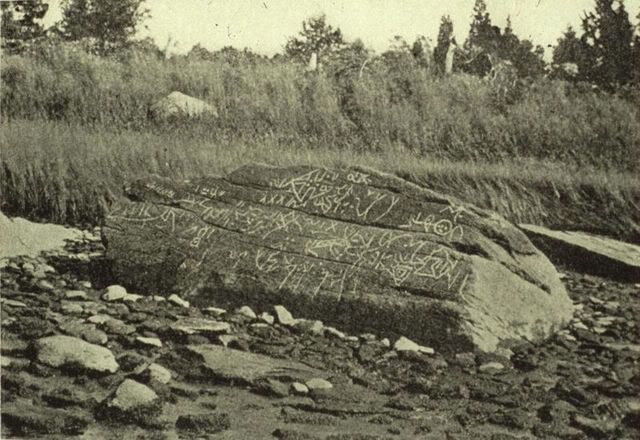
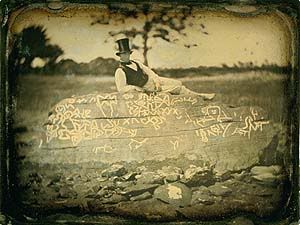
The images on the rock feature meandering lines, round-headed anthropomorphs, turkey and animal tracks, and footprints. The images were deeply carved into the rock and carving them would have required standing in water to make them.
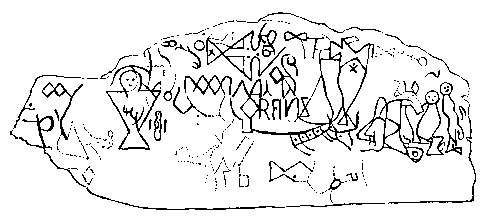
An 1830 drawing of the carvings is shown above.
The English colonists puzzled over the mysterious symbols which had been carved in the rock. The Reverend John Danforth made a drawing of the petroglyphs in 1680. Convinced that the writing on the rock was Phoenician, he sent his drawing to the Royal Society of London to see what they thought, but the English scholars were non-committal. Danforth’s drawing is still preserved in the British Museum.

Danforth’s 1680 drawing is shown above.
In 1690, the Reverend Cotton Mather, in his book The Wonderful Works of God Commemorated, wrote:
“Among the other Curiosities of New-England, one is that of a mighty Rock, on a perpendicular side whereof by a River, which at High Tide covers part of it, there are very deeply Engraved, no man alive knows How or When about half a score Lines, near Ten Foot Long, and a foot and half broad, filled with strange Characters: which would suggest as odd Thoughts about them that were here before us, as there are odd Shapes in that Elaborate Monument….”
Some seventeenth-century scholars were convinced that the markings were actually Phoenician writing. Their world view regarding Indians made it impossible to conceive of the carvings as having been done by Indians.
In 1783, Ezra Stiles, the president of Harvard University and well-known Biblical scholar, declared that the writings on Dighton Rock were the work of Phoenicians. The Phoenicians were a maritime trading culture that had flourished in the Mediterranean from about 1550 BCE to 300 BCE. While they travelled routes known to the Biblical world of this time, there is little evidence that they ventured outside of the Mediterranean. They were, however, mentioned in the Bible and thus it was assumed that they must have sailed (or rowed) across the Atlantic to the Americas.
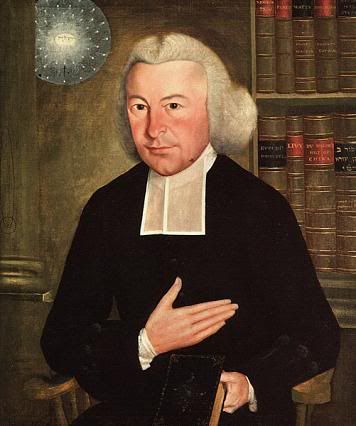
Ezra Stiles is shown above.

A map of Phoenician trade routes is shown above. While they did venture outside of the Mediterranean, they voyaged along the African and European coast lines, never out of sight of land.
The Europeans, with familiarity with the Norse sagas, had long assumed that the Vikings-a Christian Norse group-had sailed to North America by 1000 CE. Thus, in 1837, Carl Christian Rafn proposed that the carvings on the Dighton Rock were actually Norse runes and therefore proof of their presence in North America. Rafn was a Danish historian, translator, and antiquarian. He was particularly interested in determining the location of Vinland which had been mentioned in the Norse sagas. Rafn was convinced that he saw Roman numbers and the name “Thorfinn Karlsefini” in the stone.
In 1912, Edmund B. Delabarre declared that the carvings on the Dighton Rock had been done by the Portuguese. According to Delabarre, a professor of psychology at Brown University, the inscriptions on the rock had been carved by Miguel Corte-Real, a Portuguese explorer whose 1502 expedition into the western Atlantic never returned. He claimed that the carvings include the Coat of Arms of Portugal, the name Miguel Corte-Real, and the date 1511. Delabarre also claimed to have deciphered the writing as:
“Miguel Cortereal by the will of God, here Chief of the Indians.”
In 2002, Gavin Menzies, in his book 1421: The Year China Discovered America, suggests that the carvings are evidence of Chinese exploration. While the book was a best seller, most academic scholars remained unconvinced.
I haven’t seen any reports claiming that the carvings on Dighton Rock are evidence of ancient aliens from other worlds exploring and/or colonizing North America, but I suspect that there are some advocates of this hypothesis.
The petroglyphs on Dighton Rock were made by American Indians. While there are still a few people today who will dispute this, the fact remains that Indian people left petroglyphs (carvings in rock) and pictographs (paintings on rock) throughout North America, including New England. The problem today is not whether or not they were made by American Indians, but why they were made and what the symbols mean.
Let’s start with why. In general, rock art was created by American Indians for several basic reasons: (1) it was a way of recording spiritual experiences, such as vision quests, (2) it was a way of recording historical experiences, such as battles and deaths, and (3) it was a way of marking tribal territories, pathways, and usage rights. The location of Dighton Rock makes me suspect that it was a territorial marker. However, it is possible that it was a vision quest site as we know very little about vision quests among the Algonquian people who lived in the area.
As to what the symbols mean, unless we have access to the cultures which created them it is easy to misinterpret them. The best we can say is that we don’t know what they meant to the people who carved them. Present day claims by non-Indians as to their meaning are based in non-Indian imaginations, not in the actual Indian cultures.
In 1963, the rock was removed from the river and installed in a museum in the Dighton Rock State Park. In 1980 it was listed on the National Register of Historic Places.
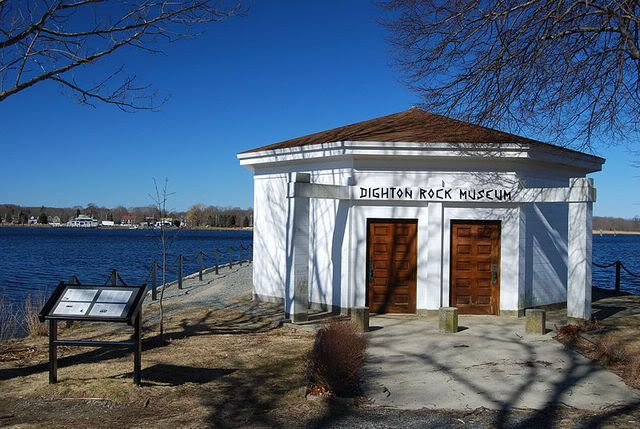
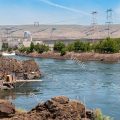
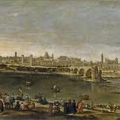
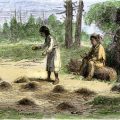
Leave a Reply